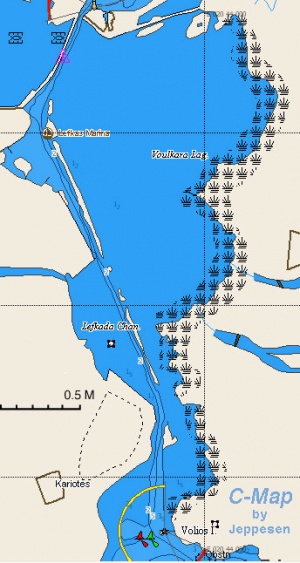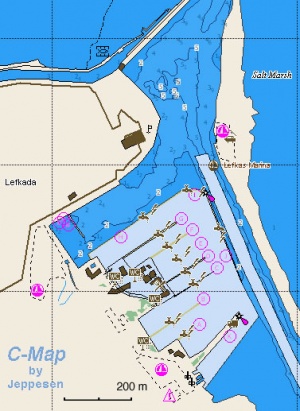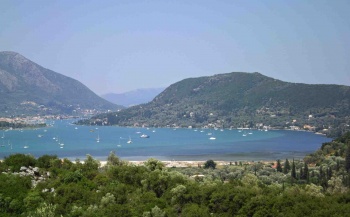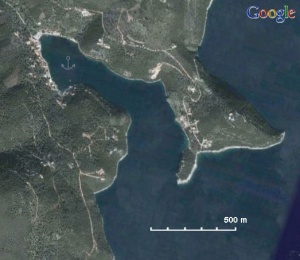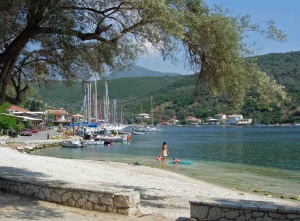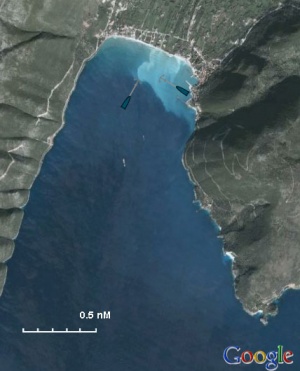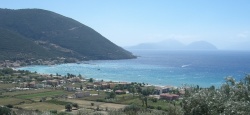Lefkas
From CruisersWiki
Lefkas (Port of Entry)
An online cruising guide for yachts sailing to Lefkas.
| | |
| | 38°50′N, 20°42.8′E |
|---|---|
| | Photo gallery |
| | Local chartlet |
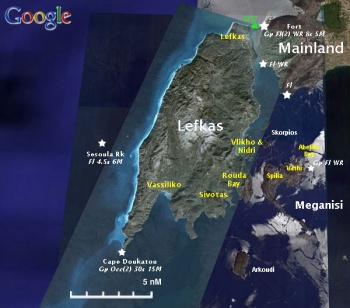
| |
Overview
Lefkas (Λευκάς) or Leukas or Lefkada (Λευκάδα) or Leukada is not really an island. It was connected to the mainland but the Corinthians around 600 BC made a canal that since then separates Lefkas from the mainland. It is now separated by shallow lagoon varying in width between 600 m and 5 km (2.6 nM). It is a hilly island with white cliffs which give it its name: white one. The tallest point of the island is Mount Stavrotas at 1158 m its area is 355.936 km2.
The earliest evidence of human settlement on the island dates from the Neolithic period. In the 7th c. BCE the town of Lefkas was founded by settlers from Corinth, who closed off the south end of the lagoon, opposite the St. George Fort, by a 600 m long mole, remains of which are still visible under water (the sunken breakwater). They also cut a channel through the spit of shingle at the north end of the lagoon, opposite the Fort of Santa Maura.
Very little is known about the early Byzantine period of Lefkas, save that a bishop from the island took part in the Convention of Nicaea (AD 325) and that the island was devastated by a huge earthquake fifty years after that. During the fifth century, the island came under attack from the Vandals and the Huns. What they did not destroy of the island was brought down by two further severe earthquakes in the middle of the sixth century. The island was incorporated into the Byzantine Theme of Cephalonia in the seventh century. The Crusades of the 11th and 12th centuries brought a period of instability to the Ionian and the island came under the control of many foreign princes. Lefkas, during this period was part of the Despotate of Epirus. Although the Crusades were supposedly an attempt to 'liberate' the Holy land and Christian lands subject to Muslim leaders, the reality of the situation was that Crusaders often fought to liberate any country so that they could keep it for themselves! In 1204, the Jewel in the Byzantine Crown, Constantinople, fell to the Crusaders and for a while, the Empire was broken. It fell as the 'duty' of Crusaders to divide up Greece amongst themselves. The Ionian islands, and nearly half of the whole Empire, went to Venice. Since Venice had to rule so many areas, it did not have a tight grip on any and it took nearly fifty years to loosen the hand of Epirus and to bring Lefkas under real Venetian control. In 1293 Nicephorus Angelus, Despot of Epirus, married his daughter to Roberto Orsini, and with her went Lefkas as a dowry. Orsini was the son of the Count of Kefalonia, subject to the Venetians. The fortress of Santa Maura was built by the Orsini family to protect the island from the increasing pirate raids. The fourteenth Century saw the government of the island in almost constant flux. Lefkas was passed, or taken, from leader to leader, leaving the islanders poverty-stricken from the constant high taxes of each leader, eager to make a quick fortune before the island be taken from him. Stability came with the rule of the Counts de Tocci and lasted for the best part of a century.
During this period, the Ottomans had slowly been advancing across Greece. The only power that did anything to halt their attacks was Venice. Battles over Greek territory between the Ottomans and the Venetians continued for nearly two centuries. Surprisingly, when the Ottoman fleet of the bloodthirsty Ahmed Pasha (who was actually French) landed at Lefkas, Venice did not respond. In 1479 the Pasha sacked the island, burning much of it to the ground and slaughtering many of the island's inhabitants. Those who were not killed, and who did not kill themselves (there are many accounts of men, women and children throwing themselves from cliff tops to escape the tyranny of the Ottomans) were sold into slavery at the bazaars of Smyrna and Constantinople. Although there were many battles for supremacy in the Ionian sea, Lefkas was the only Ionian island to come under the control of the Ottoman Empire for more than a few years. They ruled Lefkas for over 180 years, co-operating with the many pirate ships that lurked in the sheltered waters, preying on the Venetians ships that used this important shipping route. These pirates also made frequent attacks on the Lefkadians, taking goods from the towns as well as new slaves from the local population. The period of Ottoman rule went on as it had started; with great suffering to the local population. Most of the fertile land was taken by the Ottomans and the land that was not taken was subject to excessive taxes. It was only due to the industriousness of the Greeks that they survived at all. The only positive thing that was to come of the Ottoman occupation was the building of the Aghia Marina aqueduct.
The island was recovered for Venice by Morosini in 1684.With the Venetians came peace, a basic constitution and some limited self-rule. However, the prosperity that the Lefkadians expected, did not find its way into their hands. Trade was controlled by the Venetians so that the islanders were not really lifted from their poverty. By the mid-eighteenth century, the power of the Venetian Republic was wavering. Her possessions were being slowly lost, including some of the Greek ones. None of the big European powers, however, wanted to see any of the Ionian islands coming under the rule of the Ottomans; this was an important trade route, which lead on to the east. 1797 saw the start of an intense thirteen year war for the control of Lefkas. During that period, Lefkas changed hands several times.
The French took control of Lefkas in 1797 and for two years democracy reigned supreme. The island then, came into the hands of the Russians, intent of ridding the world of the Turkish threat. After that the island came under the Protectorate of Britain in military operations that were to incorporate all of the Ionian islands. New freedoms came with the British Protectorate, including the right to vote; new roads and bridges; new aqueducts; new schools and new anti-seismic building regulations to protect the islanders from a series of serious earthquakes that hit Lefkas during that period.
The smouldering of the Greek War of Independence, however, had long since started on the mainland and many Lefkadians were beginning to side with the Freedom fighters. The War of Independence officially begun in 1821 and hundreds of Lefkadian men joined the fight against the Ottomans. The Greek mainland finally won that fight in 1830 and this further induced the islanders to rise up against their own foreign rulers. Lefkas and the Ionian islands were finally incorporated into Greece with a wave of angry fighting after the Otto king of Greece was deposed and the whole country came under British rule; but that was not until 1864! Still parts of Northern Greece were occupied by the Ottomans and some border disputes still rumble on today. Lefkas remained for the early part of the twentieth century, an important organizational center for the Independence fight.
Twenty years into the twentieth century Greece marched on to Asia Minor in an attempt to "free" Smyrna (Izmir), but the effort was disastrous and more than five thousand Greeks fled to the Fort of Santa Maura which had been set up as a temporary refugee camp.
World War II saw the occupation by both Italian and Nazis soldiers across most of Greece. The troubles of the island were further compounded by the huge earthquake that shook Lefkas into ruins in 1948 and again in 1953. Walking around Lefkas Town today, you will see that many of the upper storeys of the buildings are constructed from corrugated iron in order to limit the damage from any further shakes. Many Lefkadians left the island around this time, forced to search for work abroad.
At the beginning of the 1980's the tourist industry begun to make an impact on the island. There has been some movement of the population, during the summer months at least, down from the villages of Lefkas to the coastal resorts. The impact of tourism, however, was minimal and the island remained unspoilt by it; a rich treat for its more peaceful visitor. But recently with the opening of the airport in Preveza direct charter flights are coming in daily and the island is being flooded by tourists.
Charts
- BA
- 189 Nisos Sapiénza to Nisos Paxoi
- 203 Zakinthos to Paxoi
- Imray-Tetra
- G11 Nísos Kérkira to Nísos Levkas
- NIMA
- 54280 Corfu Channel to Nisis Proti
- Greek
- 2 Ionio Pelagos
- 21 Ionio Sea - Northern Part Othonoi I. to Zakynthos I.
Radio Nets
- Coast Guard - VHF channel 12
- * Olympia Radio - VHF channel 03
Also see World Cruiser's Nets
Weather
- See Ionian Sea Weather
- Also see Ionian Sea Currents & Tides
Approaching Lefkas from the N is tricky. First you have negotiate the bridge and chain ferries into the the canal.
In spring 2011 boats drawing 2.5 metres were regularly running aground in the silted up entrance. Dredging was carried out and a string of orange buoys was laid marking the south side of the channel. Care still had to be taken as shallow spots remained, particularly near the most easterly buoys. Dredging was carried out again in spring 2012. Dredging is from a crane working on the sand spit on the north side of the channel - thus it is deepest near the shore. A yacht passing through in May 2012 and keeping only five metres off the north bank recorded a minimum depth of 3.8 metres.
The bridge opens once an hour on the hour. First the N going traffic crosses and then the S going traffic. The indication is (when they work): two triangles over a ball plus the sounding of a siren. In May 2012, the bridge had been replaced by a ferry boat acting as a temporary bridge. Check with Lefkas Marina for the schedule. Anchoring to the north while waiting for an opening is difficult as holding is poor. It is preferable to approach the canal from the north before the afternoon seabreeze fills in.
There is often a current in the canal reaching 1.5 knots.
Check-in facilities (Customs and Immigration)
Lefkas is a port of entry and you can clear here in/out of Greece.
Berthing Options
Ports
Lefkas Harbor
![]() 38°50′N, 20°42.8′E
38°50′N, 20°42.8′E
Lefkas (Λευκάς) is the main harbor on the island. It is located in the salt marshes separating the island from the mainland. Entrance to the harbor is through the dredged canal (Fort Santa Maura) and it is tricky especially from the S (Fort Saint George). There is now a marina in the harbor, so go where directed. The town, although mostly rebuilt from the ruins of the 1953 earthquake, is fairly attractive.
Anchorages
Vlikho Bay & Nidri
![]() 38°42.42′N, 20°42.92′E
38°42.42′N, 20°42.92′E
Vlikho Bay is a good all around anchorage. The bottom is mud and anchoring depths are 8-2 m. The town of Nidri is very popular with tourists. Several flotilla fleets are operating from here.
Sivotas Bay
![]() 38°37.1′N, 20°41.39′E
38°37.1′N, 20°41.39′E
Sivotas Bay is a good anchorage but several flotilla fleets are operating from here and it is very crowded. Near the shore depths are 3-8 m but further out, where you may find room, depths are about 12 m.
Vassiliko Bay
![]() 38°37.49′N, 20°35.89′E
38°37.49′N, 20°35.89′E
Vasiliko Bay or Vassiliki is a pleasant anchorage and near the white cliff from where Sappho is supposed to have jumped.
Vassiliko provides a nice little harbor with a lot of restaurants around it. It's not over crowded by tourist either and some bars have open until early morning. It's supposed to be a good spot for wind surfing. Moor stern-to along the quay. Holding is good. June 2009 -- Rodger
Warning: Water is very shallow towards the beach and on the north side within the harbor. (<1m). Be well prepared when entering the harbor as you don't have much space for maneuvering! For a sailing boat you might only use half of the harbor to park your boat. Once you're in it is beautiful.
Marinas & Yacht Clubs
Offshore Islands
- Modra
- Meganisi
- Skorpios (a private island)
Yacht Services and Repairs
Marine Stores
- At the marina Paleros Tel 2645 029117 is one of the best chandleries in the Ionian
Yacht Services/Repairs/Yards
- At the marina
Fuel, Water, & Electricity
Things to do Ashore
Tourism
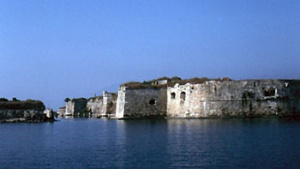 Santa Maura Click for larger view |
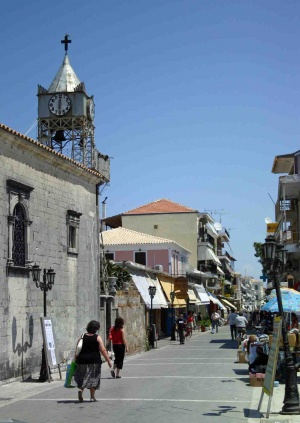 Lefkas Town Click for larger view |
From the town, it worth visiting the Fort of Santa Maura.
=Grocery & Supply Stores=
- There is a supermarket at the marina and a megastore a few blocks back
- The local wine Santa Maura is very good
- The salami from Lefkas is famous
Eateries
- Good food in the many restaurants in town
- LaVinira is an excellent small taverna
- Estatorio Frynh is particularly good but fully priced
- Restaurant at at the marina
Internet/WiFi
- At the marina
- In Internet cafés
Laundry
- In the marina
Motorbike & Car Rentals
- In town.
Garbage Disposal
There are bins around the harbor and in several anchorages.
Transportation
Routes/Passages To/From
Cruiser's Friends
Contact details of "Cruiser's Friends" that can be contacted for local information or assistance.
Forum Discussions
List links to discussion threads on partnering forums. (see link for requirements)
External Links
- Lefkas (Wikipedia)
References & Publications
See Ionian Sea.
Personal Notes
Personal experiences?
Last Visited & Details Checked (and updated here)
Date of member's visit to this Port/Stop & this page's details validated:
- July 1988 --Istioploos

- August 2009 --Nereus
- May 2012 -- Monterey

|
|---|
|
Names: Istioploos, Nereus, Athene of Lymington, Rodger, Wayward, Monterey |
| |
|---|
| | HOMEPAGE | Wiki Contents | Mediterranean | Ionian Sea | Greece | Lefkas | |
